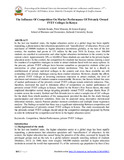The Influence Of Competition On Market Performance Of Privately Owned TVET Colleges In Kenya
Abstract
In the last one hundred years, the higher education sector at a global stage has been rapidly
expanding, a phenomenon that education specialists call “massification” of education. From a net
enrolment of 500000 students in higher education institutions globally, at the turn of the last
century, the numbers had grown to 178 million by the year 2010. In Kenya, over 300,000
students are enrolled in universities and other higher education institutions in the country in the
current cohort. Approximately 20% or 60,000 of these students are enrolled in the private higher
education sector. In this context, the competition for students has become intense creating a need
for creation of competitive strategies in order to attract students faced with too many options. In
the process, private TVET colleges have become casualties as prospective students either join
universities or other government owned tertiary institutions. This has led to a dearth in
establishment of private mid-level colleges in the country and even those available are still
contending with several challenges among them student retention. However, despite the efforts
by private TVET Colleges in investing enormous resources to attract students, the level of
enrolment and retention of students remains unsustainable. However, the factors behind this state
of market performance of the privately owned TVET colleges remain relatively unknown. This,
therefore, motivated the need to determine effect of competition on market performance of
privately owned TVET colleges in Kenya. Guided by the Porter’s Five Forces theory, the study
employed descriptive survey design targeting privately owned TVET colleges drawn from 25
counties across the country. Kathuri and Pals formula was to select a sample size of 267 colleges
for the study from which members of the management provided the data for the study through
questionnaires and interview schedules. Data was be analyzed using descriptive statisticsand
inferential statistics, mainly Pearson product moment correlation and multiple linear regression
analysis. The findings revealed that there was a significant relationship between competition and
market performance of privately owned TVET colleges in Kenya. The study recommends that
the privately owned TVET colleges should adopt the competitive strategies proposed by Porter
in order to withstand the competition and thrive in the higher education sector.

